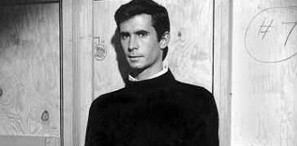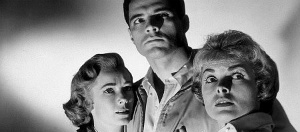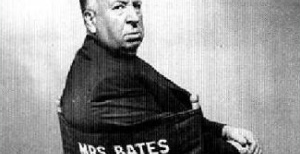
Director: Alfred Hitchcock
Writer: Joseph Stefano
Starring: Anthony Perkins, Janet Leigh, Vera Miles, John Gavin
Rating: R (USA), 15 (UK), M (Australia)
Psycho is not technically a slasher movie. In fact, it is not really a horror at all. But its influence and importance to the genre’s history can still be felt, resulting in many referring to it as the original slasher. Regardless, it provided the template for which many fictional killers would later be modelled on and remains one of the most intriguing and unnerving films of all time. Half a century on and its power to shock has not diminished, despite inferior sequels, a TV spin-off, a remake and countless imitators, it stands as a masterpiece of suggestive filmmaking.
By 1960, British-born auteur Alfred Hitchcock had spent almost forty years in the industry and directed fifty feature films, and his reputation as a master of suspense had been cemented by the likes of The Lady Vanishes, Rear Window and Vertigo. His most recent production, North By Northwest, had been another success and his TV show Alfred Hitchcock Presents was enjoying its sixth year of critical acclaim, so it seemed like a dangerous career move when he chose to adapt a dark and disturbing novel about a young, cross-dressing schizophrenic. Yet, despite Paramount, who he had been enjoying a prolific relationship with, pleading with him to walk from the project, he had the power of foresight and knew that this was too important to pass up.

When his collaboration with screen legend Audrey Hepburn, No Bail for the Judge, fell through when his star fell pregnant, Hitchcock was searching for something new and came across a recently published book entitled Psycho by Robert Bloch. Sensing something unique about the story, he purchased the rights anonymously for $9,000, immediately commissioning writer James P. Cavanagh to develop the concept into a screenplay. Unimpressed with the draft, a young writer by the name of Joseph Stefano was suggested and, despite him only having one prior writing credit to his name, made enough of an impression on the director that he was hired on the spot. His adaptation would change a few key aspects of the novel – Mary Crane would be changed to Marion, her home town would change from Dallas to Phoenix and the antagonist, Norman Bates, would become more sympathetic and likeable – though the essence and general plotline would remain the same.
Without Paramount‘s support, who saw the novel as repulsive and non-commercial, Hitchcock was forced to finance the picture independently through his company Shamley Productions, opting to shoot at Universal Studios and using the same crew that he had been working with on his television show. Knowing that an inflated budget would hinder the production, he chose to film in black and white – his last feature not to be shot in colour – which would also help avoid controversy with regards to the bloody murder scene. With an estimated fund of $806,947, Psycho was to be a far cry from his recent string of big budget espionage and action thrillers though, perhaps intentionally, these enclosed conditions helped make the finished movie even more claustrophobic.

After considering the likes of Hope Lange, Piper Laurie and his North By Northwest star Eva Marie Saint, Hitchcock eventually settled on Janet Leigh, managing to contract her for a mere $24,000, a quarter of her usual asking fee. For the role of Norman Bates, the story’s charming yet-twisted villain, he chose twenty-seven year old Anthony Perkins. Little did anyone know that the actor would be forever typecast and that the character would become one of the most iconic ‘monsters’ in cinema history. For the remaining cast, Hitchcock hired Vera Mills (who had appeared in an episode of his show), John Gavin, Martin Balsam and daughter Patricia Hitchcock, who had already worked on several of his films. Principal photography began on the 30th November, 1959, with the first day of shooting being the scene where Marion (Leigh) is pulled over by a highway patrolman. Before filming began, Hitchcock had his cast and crew raise their hands and swear to not divulge any aspects of the plot, especially the ending, to anyone outside of the production.
The first section of the film was very much in tone with the director’s previous work, which sees Marion embezzling $40,000 from her employer and fleeing across state, with the intention of starting a new life with her lover. But events take a drastic turn when she pulls into the lot of a motel, hidden far from the interstate, where she meets the owner, Norman. Taking a liking to his new guest, he invites her into his pantry where he offers her supper. It is during this scene that we see Marion’s remorse and her change of heart, where she decides that she will return the money and face the consequences. But soon after, when she returns to her room and takes a shower, Norman spies on her through a small hole in the bathroom wall. A couple of minutes later, the door opens and a figure appears at the shower curtain, repeatedly slashing and stabbing her with a large carving knife. The killer, whose features are covered by long hair and wearing a dress, runs out of the room and soon afterwards Norman discovers the gruesome crime, opting to hide the evidence in order to protect his ‘mother’ from being discovered.

It is with this scene that Psycho suddenly changes from a typical Hitchcock movie to a menacing study of murder. The sequence itself, which would become one of the most iconic images of all time, would take several days to shoot and would consist of somewhere between seventy-one and seventy-eight angles and fifty cuts. When it came to the censors viewing the finished product, the director was ordered to make edits to the scene, due to the inclusion of one of Leigh’s breasts and shots of the knife penetrating her stomach. What was most amusing was that these shots did not actually exist – the scene is suggestive, not graphic – and when Hitchcock resubmitted the film a few days later with no changes made, the censors were none the wiser and granted the movie a certificate.
Reviews were mixed upon its initial release, with many critics disgusted how such a respected and loved filmmaker could produce such smut. Yet over the years, the industry began to recognise just how perfect and important Psycho really was. It would become influential on the horror genre almost immediately, with the world’s first ‘splatter’ movie, Herschell Gordon Lewis’ Blood Feast, being the first explicit imitator (whereas Psycho had a subtle shower scene, Blood Feast would contain a scene where a female victim was brutally murdered in a bath whilst being visibly naked on screen). Other followers of this new style included William Castle, Mario Bava and Roger Corman, with the gothic vampire and monster movies of the 1950’s being replaced with psychological tales of demented serial killers with a taste for the macabre. Hitchcock sadly passed away in April, 1980, and would therefore not live to see the full impact that his masterpiece would have on the genre, with John Carpenter’s Halloween leading the way for the slasher boom that would follow, all of which would contain some sexually confused killer (Norman was revealed at the end of Psycho to be a transvestite, who dressed as his mother and committed the murders, unaware of his own psychological problems), though they would up the gore quota and the amount of murders and sexual content. Even to this day, fifty years on, Psycho remains an important part of the genre and one of the greatest motion pictures ever made.


4 Responses to A BOY’S BEST FRIEND pt.1 – Psycho (1960)